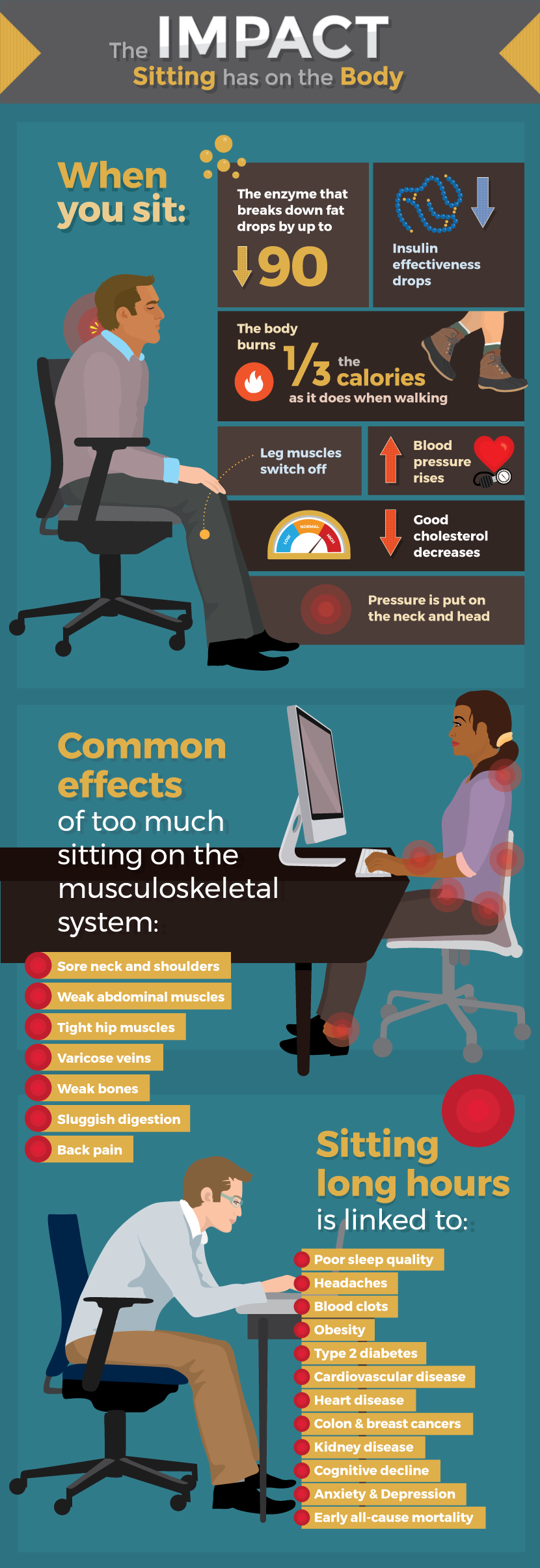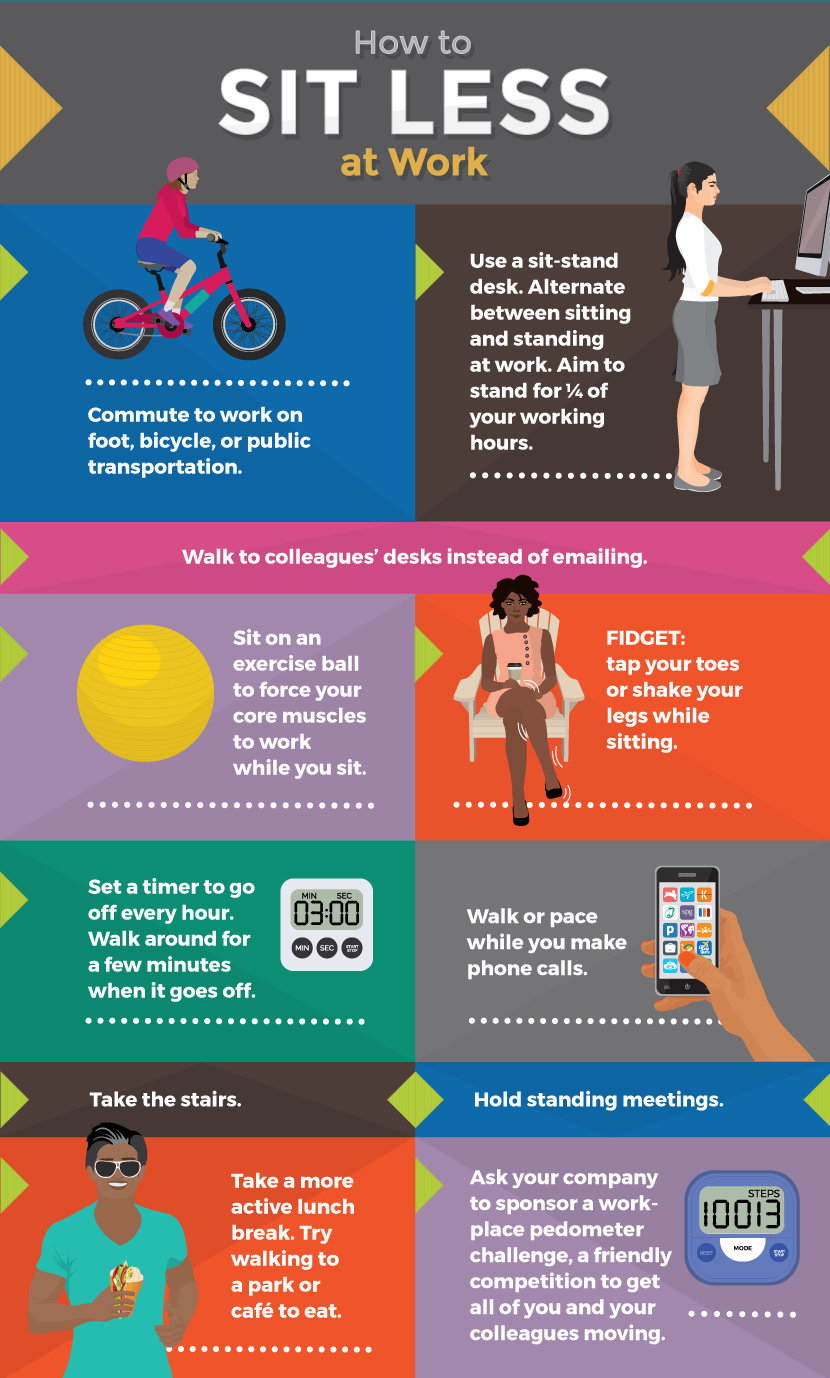Take a Stand on Sitting
When you think about risky jobs, you probably think about mining, steel work, or commercial fishing, not typing memos in a corner office. However, researchers are increasingly raising the alarm that office jobs carry substantial health risks because they require people to sit for long periods. Sitting for 8 hours or more per day increases a person’s risk of premature death by up to 60 percent, according to a 2012 study of a million adults published in the Lancet. Sitting causes more deaths than obesity and poses as great a threat to public health as smoking, according to the researchers’ analysis.
Are you concerned your sedentary job may be harming your health or shortening your life? It’s time to take a stand against sitting. Keep reading to learn why frequent physical activity during the day is necessary regardless of how much you exercise, and discover how to move more at work to stay healthy and productive.

Exercise Is Not Enough
Health experts recommend approximately 150 minutes per week of moderate to vigorous exercise to maintain physical health.https://www.theatlantic.com/health/archive/2016/08/the-new-exercise-mantra/495908/ Unfortunately, more than 80 percent of Americans don’t get that much exercise.http://www.cbsnews.com/news/cdc-80-percent-of-american-adults-dont-get-recommended-exercise/ Worse, even frequent exercisers are at risk for health problems if they’re sedentary for long periods for the rest of the day.https://www.washingtonpost.com/lifestyle/wellness/even-with-exercise-long-periods-spent-sedentary-are-deemed-a-health-risk/2011/07/07/gIQAicwRAI_story.html?utm_term=.acfa15631977 The human body is designed to move frequently.https://www.acefitness.org/blog/5282/proof-that-the-human-body-was-made-to-move
What types of activities are best? Any movement is better than none. In one study, people who took the most frequent breaks from sitting during the day (even for just a minute) had significantly smaller waistlines and lower markers of inflammation than those who took the fewest breaks.https://www.livescience.com/9262-smaller-waist-breaks-sitting.html In other studies, people who fidget are consistently thinner and healthier and have lower morbidity risks than those who don’t.http://www.ajpmonline.org/article/S0749-3797%2815%2900345-1/abstract In a large observational study, women who spent the most time doing light household activities such as cleaning, home repair, gardening, or climbing stairs had the lowest risk of breast cancer (Notably, vigorous exercise was not associated with a reduced risk of breast cancer in this study).http://cebp.aacrjournals.org/content/16/1/36.full To be healthy, a person needs to be moderately active during the day. https://www.ncbi.nlm.nih.gov/pmc/articles/PMC2996155/

Take a Stand
With all of the headlines about the ills of sitting, a standing desk may sound like the solution. Warning: staying in a static position for a long time is hard on the body whether you’re sitting or standing. Moreover, standing for long periods, as people do in certain jobs, is associated with a significantly greater risk of developing serious varicose veins in the legs, according to a 2015 study.https://www.ncbi.nlm.nih.gov/pmc/articles/PMC1740939/
With those caveats, sit-stand desks provide many benefits over regular desks because they allow office workers to change position more frequently and may encourage more walking. Research on sit-stand desks is in its infancy, but a few studies suggest standing for some of the time at work may also increase workers’ productivity by approximately 10 to 15 percent.http://www.cnn.com/2016/06/08/health/standing-desk-productivity/index.html
If you don’t have access to a sit-stand desk, you can fashion your own. If you have a laptop, it’s best to buy a wireless keyboard and mouse so you can keep your screen just above eye level and your hands at waist height. Then try one of these tricks:
- Set a chair and low box on your desk. Put your laptop on the chair and the keyboard on the box.
- Set a box on a waist-height countertop. Put your laptop on the box and your keyboard on the countertop.
- Use a bookshelf. Put your laptop on a shelf at eye level and your keyboard on a shelf at waist height.
No matter which sit-stand arrangement you use, alternate standing with sitting and gradually transition to standing more. Aim for eventually standing for about one-fourth of your working hours. Use standing as an excuse to walk and move more, not less.
If possible, it’s also beneficial to sit on the floor for some of your working hours. Chairs are uncommon in many parts of the world, and some health experts argue chairs are not an improvement on the floor when it comes to sitting.http://www.marksdailyapple.com/floor-living-do-you-spend-enough-time-on-the-ground/ Sitting on the floor increases the mobility of the hips, encourages good posture, and makes people want to naturally change positions often.https://nutritiousmovement.com/your-position-in-life/ It also requires people to rise from the floor to standing, a movement that requires a surprising amount of muscular strength, flexibility, and balance. Cardiologists can even predict longevity with the sitting-rising test, a simple assessment of whether a person can rise from the floor without using their hands.http://discovermagazine.com/2013/nov/05-sit-down
Resting is a normal and natural part of life. Anthropologists have documented at least a hundred common resting postures around the world.http://www.jstor.org/stable/666393?seq=1#page_scan_tab_contents However, it’s not optimal to stay in any one resting position for a long time. It’s better to move to new positions frequently, and get up and walk around often.https://nutritiousmovement.com/your-position-in-life/

Jump on the Treadmill
What about walking while you work? Treadmill desks are growing in popularity and they offer benefits, according to some research. In one study, subjects who walked while they worked for two hours a day for two months slept better and significantly improved their blood pressure.https://well.blogs.nytimes.com/2015/06/10/the-downside-of-treadmill-desks/
However, walking on a treadmill is biomechanically not the same as walking on land, and it can contribute to hip, knee, and pelvis problems in some people, according to biomechanist Katy Bowman. On a treadmill, you must use your hip flexors to propel yourself forward instead of your lateral hip and glute muscles. Moreover, if you’re typing at the desk, you can’t swing your arms as you typically would as you walk, which can contribute to lower back pain.http://www.chicagotribune.com/lifestyles/health/sc-health-0709-fitness-treadmill-20140711-story.html The benefits may outweigh the risks, though, especially if the alternative is sitting all day, which is known to be hazardous.
Expect a learning curve if you decide to jump on the treadmill. New treadmill desk users performed much worse on tests of cognitive abilities than their seated colleagues in a study. Some new users also report dizziness and overuse injuries, such as foot inflammation. However, a longer-term study suggests workers are as productive as seated colleagues after using a treadmill desk for several months.https://www.forbes.com/sites/susanadams/2014/03/11/new-study-treadmill-desks-boost-productivity/#5d59dda544f9

Escape the Desk Sentence
If you’re sedentary for long periods of the day, commit to being more active at the office. At first, set a timer for every 30 minutes to remind yourself to get up and move. Also, pay attention, and you’ll notice your body prompting you to get up periodically. Here are a few common signals: restlessness, inability to pay attention, fatigue, headache, eyestrain, and tension in the back, neck, and shoulders.https://www.nemours.org/content/dam/nemours/www/filebox/service/preventive/nhps/pep/braininmind.pdf Do these symptoms sound familiar? Take your body’s messages seriously – get up for a few minutes, and walk around. If possible, look outside at the horizon to relax your eyes. When you get back to your desk, change your position. You’ll feel better and be healthier, and you’ll probably also be more productive. Brief breaks have been shown to vastly improve the brain’s ability to focus.https://news.illinois.edu/blog/view/6367/205427
No matter how much you move at the office, computer jobs are more sedentary than the daily work most humans did throughout history. When you’re not at work, commit to being active regardless of your age. Researchers used to think humans inevitably lost muscle mass, flexibility, and mobility as they aged. However, many of the physical changes we’d assumed were due to aging are actually due to physical inactivity, according to newer research.https://well.blogs.nytimes.com/2011/11/09/aging-well-through-exercise/ Regular physical activity keeps people strong and agile throughout life. Any type of movement is better than none. Walk, run, crawl, roll, squat, stretch, jump, swim, hang, and play. Or clean your house, tend your garden, mow your lawn, and commute and do errands on foot. Your body and brain will thank you.
Embed the article on your site

